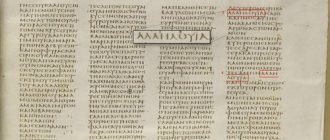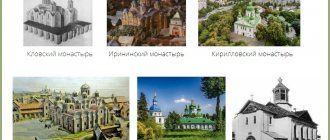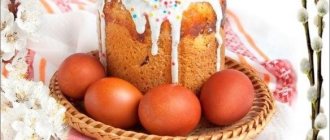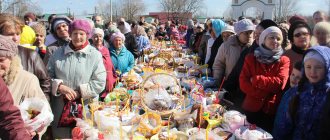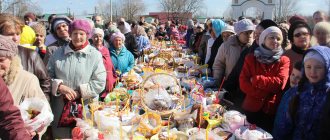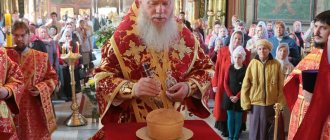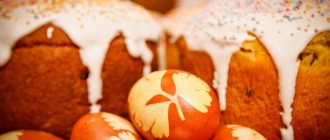Christians all over the world associate the word “Easter” with the most joyful and bright feelings. This concept has several meanings and comes from ancient languages. It is used mainly to refer to the holiday during which the Resurrection of Christ is celebrated. At the same time, the word Easter has several meanings, and scientists put forward different versions about its origin.
In Dahl's dictionary
and. festival of the Jews in memory of their exodus from Egypt. | The lamb that was slain and eaten by the Jews at this festival. | The annual celebration of Christians, in memory of the rise of the Savior from the dead; Bright Sunday of Christ, holy, holy week. | Velikorussk. a consecrated stack of cheese, cottage cheese, which is used to break the fast on this day; and Maloros. Easter cake, consecrated for the same purpose, korovai. What an Easter - wider than Christmas! Who dies on Easter - an egg in his hand (tver.). After Matins on the first day of Easter, they go to celebrate Christ with the departed and bury the egg in the grave. Anyone who sleeps through Matins on the first day of Easter is doused or bathed with water on Monday. Bones from a dead lamb (pig, bird, etc.) are buried in the field so that hail does not hit, south. Easter, relating to this day and celebration. Easter w. a table containing keywords and circles for finding the time of Easter and other moving holidays. Pasochnitsa w. a kind of wooden box, falling apart at the bottom, with decent carved decorations inside, for pressing Easter (cheese, cottage cheese) in it.
"Christ is Risen!" and other Easter greetings in different languages
We all know that Orthodox Christians congratulate each other like this: “Christ is Risen!”, to which the answer certainly follows: “Truly He is Risen!” After this, you are supposed to kiss your interlocutor three times on each cheek in turn. This greeting is called Christening.
Another similar version of congratulations is also allowed, according to the norms of the modern Russian language: “Christ is risen!” - “Truly risen!” It’s just that the first version is much closer to the original church language. Moreover, we still largely live by his canons, although we ourselves may not pay attention.
For example, the prayer “Our Father”, where the word “Father” is used, not “Father”. Let’s remember Pushkin’s famous fairy tale about the goldfish, where she turned to her grandfather: “Well, what do you need, Starche?”
The thing is that for a long time in the Russian language there were not 6, but 7 cases. And the seventh case was called vocative. This case included special forms of nouns like those we discussed above.
And again, it is very difficult to change the popular habit, because we still say: “Lord,” “son,” “daughter,” etc. In most cases these are already colloquial expressions, but it seems they will exist for a very long time.
Now let’s look at how our near and distant neighbors greet each other when they congratulate each other on the great holiday of Easter:
| language | greetings | answer |
| Belorussian | Hrystos uvaskros / uvaskres! | Sapraўdy ўwaskros/ўwaskres! |
| Ukrainian | Christ is risen! | He is truly risen! |
| Czech | Kristus je vzkříšen! Kristus vstal z mrtvých / zmrtvýchvstal! | Vskutku je vzкříšen! Vpravdě vstal z mrtvých! Skutečně vstal! Opravdu zmrtvýchvstal! |
| German | Christus (Der Herr) ist auferstanden! | Er ist wahrhaftig auferstanden! |
| English | Christ is risen! | He is risen indeed! Indeed, He is risen! Truly, He is risen! |
| French | Christ est resuscité! | En vérité/ Vraiment, Il est ressuscité! |
| Italian | Cristo and risorto! | È veramente risorto! |
In each case, the words of greeting and response are translated exactly as in our language. It’s just that in some places the answers are longer, in others they are shorter. And this is no coincidence, because what does Easter mean for Christians? This is the day when the Savior was resurrected.
Therefore, the Easter greeting reflects the whole essence and sacred meaning of this celebration. In a way, this is similar to how we say: “Happy New Year!” With new happiness!" That is, the New Year is a time of good renewal, and Easter is the holiday when Christ rose from the dead and saved all believers from their sins.
In Ozhegov's dictionary
EASTER, -i, f. 1. (P capital). In Judaism: a spring holiday in memory of the exodus of the Jews from Egypt, freed from Egyptian slavery. Bake matzo for Passover. Jewish P. 2. (Capital P). For Christians: a spring holiday associated with faith in the miraculous resurrection of Jesus Christ, celebrated on the first Sunday after the spring equinox and full moon. Service on the first day of Easter. The solemn ringing of bells for Easter. Easter chants. 3. A sweet curd dish in the shape of a tetrahedral pyramid, prepared for the Christian holiday of Easter. Tvorozhnaya p. || adj. Easter, -aya, -oe (to 1 and 2 meanings) and Easter, -aya, -oe (to 3 meanings). Easter week. Warm Easter days. Easter eggs.
Easter
I. NAME
Evp. The word Pesach
in the Bible means, on the one hand, the holiday of P., and on the other, the holiday sacrifice, Passover. lamb This word is derived from the verb, primary. meaning “to limp”, and then received the meaning “to jump over something”, “to leave untouched”. When the Lord struck the firstborn in Egypt, He did not affect the houses of the Jews, but “jumped over” them (Ex. 12:13). P. should remind Jews of this event.
II. EASTER EXODUS
1)
Pharaoh did not want to release the enslaved. Israelites into the desert even after God, in order to break his stubbornness, sent nine plagues on the Egyptians. And then Moses announced to Pharaoh the last, most severe punishment - the death of all Egyptian firstborns (Ex. 11: 4-6). This punishment was supposed to force Pharaoh to release the Israelites from the country (Ex. 11:8);
2)
For this day, the Jews had to carefully prepare, which meant for them the same time. and the test of faith (Heb. 11:28). Starting from the 10th day of the month of Abib, i.e. from the beginning Israel. year (Ex. 12:2), each head of the house had to take care of a one-year-old, without blemish, lamb or kid for his family - a lamb (Ex. 12:3.5). If a family was too small to eat the whole lamb at one time, it had to join a neighboring family so that the number of participants in the meal would be sufficient (Ex. 12:4). The Lamb should have been slaughtered on the 14th of Abib “at evening” (lit. “at dusk”), i.e. between sunset and darkness (Exod. 12:6; Lev. 23:5; Num. 9:3.5.11; cf. Deut. 16:6). A bunch of hyssop was to be anointed with the blood of the lamb on the doorposts and threshold of every Hebrew. home, after which no one had the right to go out the door (Ex. 12:7.22). The lamb had to be baked whole - with head, legs and entrails; it was forbidden to break a single bone, it was forbidden to eat meat raw or boiled (Ex. 12:8.9; cf. Deut. 16:7 and 2 Chron. 35:13; ⇒ Boil, cook, 1). The Passover lamb had to be cooked in the house. Includes Easter. meals included, kp. moreover, unleavened bread and bitter herbs (Ex. 12:8). All leftover food was to be burned (Exodus 12:10), and all participants in the meal were to be ready to set out immediately (Exodus 12:11);
3)
this baked The whole lamb was a symbol of unity and integrity. P. should have eaten in one house (Ex. 12:46) before the Lord, Who “is alone” (Deut. 6:4). In one day He brought about the liberation of Israel (Ex. 12:41), and for this His people must serve Him alone (Deut. 6:5). Unleavened bread (unleavened bread) is quickly baked “bread of disaster” (Deut. 16:3); later they reminded again and again of the haste during the exodus (Ex. 12:34.39); Bitter herbs symbolized the bitterness of life in Egypt. slavery;
4)
when the Israelites celebrated the Passover. meal, the Lord at midnight from the 14th to the 15th of Abib “struck all the firstborn in the land of Egypt” - from the firstborn of Pharaoh to the firstborn of the prisoner, as well as “all the firstborn of the livestock” (Ex. 12:29.30). However, the people of Israel were spared for the Passover. lambs who died in place of the firstborn (cf. ⇒ Lord's Supper, I and II). Thus the way for the ⇒ outcome was opened;
5)
The opinion is often expressed that even before Israel. P. there was an ancient form of this holiday - the spring holiday celebrated annually by nomads; such an assumption can be made on the basis of a number of cultural and historical. data. However, there are no sources earlier than the Bible (or even contemporary ones).
III. PRESCRIPTIONS OF THE LAW ON THE REPEAT OF EASTER
1)
as a constant reminder of the fundamental will save. act of God, about the liberation of Israel. people from Egypt slavery, the Law prescribes that the Israelites annually (Exodus 13:10), from the time of the conquest of the Promised Land (Exodus 12:25; Exodus 13:5), perform P., connecting it with the Feast of Unleavened Bread (Exodus 12:14; Num. 28:16.17; Deut. 16:1–8; cf. also Ezek. 45:21–24). Easter. The lamb was allowed to be slaughtered and eaten only in a special sacred place. place (Deut. 16:5-7), for which all Israel. men were to appear “before the face of God” (Deut. 16:16). All fathers were to explain the meaning of the holiday to their sons (Ex. 13:8). No foreigner, settler or mercenary had the right to participate in this common meal, which reminded the Israelites of the deliverance of their ancestors from slavery and forced them to relive this great event in their hearts again and again (Ex. 12:43.45). Only after completing ⇒ circumcision, a purchased slave, and, if desired, a foreigner, could be allowed to participate in the holiday (Ex. 12:44.48). Anyone who was prevented by ritual impurity or departure from celebrating P. on time could do so a month later (Num. 9:10–12), during the so-called. small P. Anyone who neglected the holiday out of disobedience was subject to the death penalty (Num. 9:13), for he himself excluded himself from Judas. society;
2)
directly adjacent to P. was the Feast of Unleavened Bread, which lasted from 15 to 21 Abib (Exodus 12:18), which, on the one hand, also reminded of the exodus (Exodus 12:17; Deut. 16:3; cf. Deut. 26 :1–11), and on the other hand, it was the holiday of the beginning of the harvest (Lev. 23:10–14). The first and last days of the holiday were Holy Days. meetings, when only such work was allowed that was related to food preparation (Ex. 12:16; Lev. 23:7.8; Num. 28:18.25). Holiday sacrifices were offered daily (Lev. 23:8; Num. 28:19–24), to which were added the voluntary sacrifices of the Israelites (Ex. 23:15). During the entire holiday, it was forbidden to eat or generally keep leavened bread in the house (Ex. 12:18–20; Lev. 23:6). On the trail. the day after the Sabbath (i.e., after the first holiday Saturday), on the second day of the holiday (as the Septuagint and Josephus understand it), the priest offered the first sheaf as a wave offering and a lamb as a burnt offering. Until that time, the fruits of the new harvest were not allowed to be eaten (Lev. 23:9–14). This is probably the first simultaneous sacrifice. symbolized the general beginning of the harvest (Deut. 16:9). As in P., during the Feast of Unleavened Bread, violation of God's commandments was punishable by death (Ex. 12:19);
3)
description of P. and the Feast of Unleavened Bread in Deut. 16 reveals some differences from other regulations concerning these holidays. Here, it seems, it is allowed to bring as Passover. the sacrifices also include cattle (Deut. 16:2; however, perhaps other festival sacrifices are being referred to) and only one day of assembly at the end of the festival is mentioned (Deut. 16:8; see also Exod. 13:6). It was allowed to set off on the trail. morning after Easter. meals (Deut. 16:7), as happened during the P. exodus (Ex. 12:11.39).
IV. EASTER HOLIDAYS IN THE HISTORY OF ISRAEL
The holidays of P. are described in detail only a few times: after the celebration of P. at Sinai (Num. 9:1–5), it was celebrated during the entry into Canaan: then the Israelites celebrated P. in Gilgal and the following. day they ate unleavened bread and fried bread. grains from the harvest of this land, after which the fall of manna stopped (Joshua 5:10–12). The Feast of Unleavened Bread is not mentioned. After the construction of Solomon's temple, P. began to be celebrated regularly (2 Chronicles 8:13). Of great importance are the two feasts of P., celebrated under the kings Hezekiah (2 Chronicles 30) and Josiah (2 Kings 23:21–23; 2 Chronicles 35:1–19), when for the first time after the division of the kingdom the Israelites gathered together again, from all tribes (2 Chron. 30:1.11; 2 Chron. 35:18). However, if P. Hezekiah was performed in the second month (2 Chron. 30:2), according to. regulations, set out in Numbers 9:10, then Josiah celebrated it in the first month, as required by the Law (2 Chron. 35:1). In both cases, P. was followed by the Feast of Unleavened Bread (2 Chronicles 30:21; 2 Chronicles 35:17).
V. PASSOVER IN THE ERA OF LATER JUDAISM
Late Jud. tradition clearly defines the rules for celebrating P., conditioned by specific ones. the situation of the outcome, have lost their relevance: the choice of the lamb on the 10th day of Abib, the anointing of the doors with blood, the ban on leaving the house, the willingness of the participants in the meal to set off. Victim The lambs (the number of which reached several tens of thousands) were slaughtered on the 14th of Nisan, approx. from 15 o'clock day, in the Jerusalem Temple. The lamb was slaughtered by its owner or the one to whom he entrusted to do it; the priests collected the blood into bowls, the bowls were handed to one of the priests, who poured the contents at the foot of the victims. altar. During the slaughter of the lambs, the Levites sang Psalms 112–117 (the so-called hallel
). The lambs were to be eaten within the boundaries of Jerusalem. At the same time, the place of the family community increasingly began to be occupied by a group of pilgrims who came to the holiday and agreed to eat Easter together.
VI. THE EASTER DURING WHICH JESUS DIED
1)
acc. Ev. from John, Jesus died on the 14th of Nisan, on the eve of P. (John 19:14), as a true sacrifice. The Lamb, of whom not a single bone was broken (John 19:36); On the 13th of Nisan, Jesus dined for the last time with His disciples (John 13:1). His burial took place on the evening of Nisan 14 before the onset of Saturday, which is called “great” (John 19:31), apparently because that year the holiday coincided with the calendar Saturday. In this case, the morning of the resurrection corresponds to the first day of the week (John 20:1), when the first fruits of the new harvest were brought in (see above, III.2). Ap. Paul testifies that Christ was sacrificed for us as the Passover. lamb (1 Cor. 5:7) and rose again as the firstborn of the dead (1 Cor. 15:20.23). The dating of the Evangelist John is confirmed by Babylon. The Talmud, which also calls the eve of Passover the day of Jesus' death;
2)
synoptic The Gospels call the day of resurrection the first day of the week (Matt. 28:1; Mark 16:1.2; Luke 24:1), and the day of death is the eve of Saturday (Matt. 27:57.62; Mark 15:42; Luke 23: 54), however, they do not mention the eve of P. At the same time, they unanimously call the day of the Supper of Jesus with his disciples “the first day of unleavened bread,” when they sacrificed the Passover. lamb (Matt. 26:17; Mark 14:12; Luke 22:7), i.e. 14th Nisan. Thus, unlike John and Paul, they place the day of Jesus’ death on the 15th of Nisan, a festive Saturday, thereby simultaneous. turns out to be the eve of the next. followed by calendar Saturday. At the same time, it remains incomprehensible that the Jews who took Jesus into custody had stakes with them (Matt. 26:47.55; Mark 14:43.48; Luke 22:52), which, not being actual weapons, fell under Saturday ban; kp. Moreover, Joseph of Arimathea bought linen in the evening (Mark 15:46), which also could not be done on Saturday;
3)
this contradiction between the testimonies of John and the Synoptics can be resolved in two ways: a) the day on which the Lord’s Supper took place is called “the first day of unleavened bread” (see Matt. 26:17; Mark 14:12; Luke 22:7); this may be due to the fact that the evangelists, as is customary among Jews, attribute the time of the meal, which took place on the 13th of Nisan after 6 pm, to the 14th of Nisan. In this case, a meal was prepared for Jesus without the Passover lamb, since the slaughter of lambs was carried out only for the next day. day; b) it is known that there were disputes between the Pharisees and Sadducees about what day to celebrate the holiday ⇒ Pentecost. Of particular importance here was the circumstance whether P. fell on the day itself. preceding the Sabbath, or on the Sabbath itself. (In the year of Jesus' death, P. was celebrated on Saturday.) It is possible that the disputing parties reached a compromise, as a result of which the Sadducees celebrated their P. a day later than the Pharisees. If we assume that this was the case in the year of Jesus’ death, then Jesus celebrated P. at an earlier date (see Matt. 26:18), i.e. on a day that according to the calendar was Nisan 13, but the Pharisees considered it already Nisan 14, i.e. on the day when P. should have been celebrated according to the Law; and the Sadducean priests considered P. trace. day (John 18:28). Then the death of Jesus, which occurred “about the ninth hour,” i.e. OK. 3 o'clock in the afternoon (see Matthew 27:46.50 and parallel passages), coincides with the official. the hour of the slaughter of the Passover lamb among the Sadducees, while for the Pharisees this day was already the first Saturday of the Feast of Unleavened Bread and at the same time. day of preparation for the calendar Saturday of the current week. If this assumption is correct, then the discrepancy between the data in the Gospels becomes understandable, justified and ceases to seem contradictory.
In the Encyclopedia Dictionary
(Greek pascha, from Hebrew Pesach, lit. - passage), spring Jewish and Christian holiday. In Judaism, it is celebrated in honor of the “exodus” of the Jews from Egypt; the idea of waiting for the Messiah is introduced into the celebration of Easter. In Christianity, the holiday is associated with the doctrine of the resurrection of Jesus Christ. Celebrated by believers on the first Sunday after the spring equinox and full moon. To calculate the dates of celebration, tables (Easter) are compiled. For Orthodox churches, Easter falls between March 22 and April 23 according to the Julian calendar (the so-called Old Style).
Under what circumstances was this holiday established?
However, as many years passed, there were too many Jews. The Egyptians did not like this, they began to oppress them. They were forced to work hard to build pyramids. The Jews suffered and died, and they were also beaten by the overseers.
Then the pharaoh issued an order to destroy all male babies born . But Moses was still saved from execution by his mother, who floated him down the river in a basket. Luckily, just at that time the pharaoh’s daughter went to swim in that river and noticed the baby. She took him to the palace and raised him.
Moses grew up, and the time had come to fulfill the mission God had entrusted to him. The Lord Himself appeared to him in a burning bush (a prototype of the Mother of God) and ordered him to lead the Jewish people out of Egypt.
He went to Pharaoh and made his request. He did not immediately fulfill it, promised and refused many times. For this, Egypt was struck by various disasters.
Terrible executions were carried out on the country one after another:
- The rivers turned to blood.
- Clouds of toads were found in the fields.
- People were eaten by midges, mosquitoes and other blood-sucking creatures in huge numbers.
- The appearance of new insects - dog flies.
- Livestock began to die without exception.
- People were struck by various ulcers.
- Thunder and fiery hail.
- Locusts ate the fruits in huge numbers.
- Darkness for several days.
- Older children in families died.
The last execution turned out to be the most terrible. Pharaoh's son died, and he issued a command to release the Jews.
References
- ↑ a b
Father Jordi Rivero. "Easter " . Retrieved April 4, 2012 - ↑ a b
Royal Spanish Academy. "Easter " . Retrieved April 3, 2012 - ↑ a b
Catholic.net. "Easter Sunday". Retrieved April 3, 2012 - Benedict XVI (12 April 2009). "The Sermon of His Holiness Benedict XVI". Archived from the original on March 16, 2012. Retrieved April 4, 2012
- Aveni, Anthony (2004). "The Easter/Passover Season: Connecting the Broken Circle of Time," Book of the Year: A Brief History of Our Seasonal Holidays. . Oxford University Press. pp. 64-78. ISBN 0195171543.
- “Easter is the most important holiday for Christians, because it gives new meaning to life” (undefined). The present. March 4, 2010. Retrieved April 3, 2012
- Teresa Fernandez. "Easter time". Retrieved April 4, 2012
- ↑ Bachiller, Raphael (April 23, 2011). "This is how the date of Holy Week changes". World _ Retrieved April 3, 2012
- Penitential Brotherhood of Holy Week - LA VERÓNICA. “When is the next Holy Week?” . Retrieved April 3, 2012
- Children of the Divine Will. “How is the Easter date of the Resurrection calculated?” . Retrieved April 3, 2012
- Teresa Fernandez. "Easter Sunday and Paqua traditions". Archived from the original on April 10, 2012. Retrieved April 3, 2012
- “Easter eggs, a sweet tradition that gains more and more followers every year” (undefined). ABC. April 2, 2012. Retrieved April 3, 2012
- ASALE, RAE-. "Easter | Dictionary of the Spanish language". Dictionary of the Spanish Language - Tercentenary Edition
. Retrieved February 18, 2022. - "Easter - Catholic Encyclopedia". ec.aciprensa.com
. Retrieved February 17, 2022. - Christmas Easter
- "1 Corinthians 15, 14". And if Christ has not risen, then our preaching is in vain, and so is your faith. Archived from the original on April 3, 2012. Retrieved April 3, 2012
- Catholic Church. "Catechism of the Catholic Church: Confession of the Christian Faith". Archived from the original on April 19, 2012. Retrieved April 3, 2012. “The Resurrection of Jesus is the culminating truth of our faith in Christ, believed and lived by the first Christian community as the central truth handed down as fundamental by Tradition.”
- Catholic Church. "1 Corinthians 5". Archived from the original on April 3, 2012. Retrieved April 3, 2012
- "Orthodox Easter" . Retrieved April 4, 2012
- ↑ Travelnauta (April 3, 2009). "Easter eggs, customs and traditions". Archived from the original on April 14, 2012. Retrieved April 4, 2012
Easter Sunday Traditions
Main article: List of Easter celebrations in Spain
Holy Week in Spain
Main article: Easter in Spain
In many Holy Weeks in Spain, Easter is the day on which the longest week ends. In Malaga or Seville, for example, there is a procession of the exit of the Risen Christ, which represents the moment when Jesus of Nazareth rises and leaves his tomb. In Granada, up to three Brotherhoods celebrate the Joy of the Risen Christ.
Easter Egg
Main article: Easter egg
Decorated eggs.
The exchange of Easter eggs, first with sugar and for five centuries with chocolate, is widespread in Germany, Portugal, Romania, Bulgaria, Slovakia, Italy, France, Spain, Czech Republic, Austria, Switzerland, Argentina, Brazil, USA. , Bolivia, Chile, Uruguay and in some areas of Mexico.
The fact that the egg is associated with fertility, and the fact that Easter coincides with spring in the northern hemisphere, the season of fertility par excellence, makes it a symbol of Easter throughout Europe. Therefore, soon the confectioners of that time began to make them from different ingredients. First sugar, then chocolate.
In countries of the Orthodox tradition, raspberry eggs are exchanged in memory of the blood of Christ. [ 19 ] The Armenians empty them and decorate them with images of Christ and the Virgin Mary. And in Poland and Ukraine, for Easter they make works of art with melted wax on its shell. [ 20 ]
Religious practice
Catholic, Evangelical and other Christian churches
The celebration of Easter occurs in different ways among Western Christians. The traditional liturgical practice, practiced by Catholics, some Lutherans and Anglicans, begins on the night of Holy Saturday with the Easter Vigil. Thus, the most important liturgy of the year begins with the blessing of the Easter fire in complete darkness, the lighting of the Easter candle (symbol of the risen Christ) and the singing of Exultet
(or Easter proclamation), attributed to Saint Ambrose. Milana.
After this, numerous readings from the Old Testament are read: passages such as the creation stories, the sacrifice of Isaac, the crossing of the Red Sea, and the prophesied coming of the Messiah. This part of the service ends with the singing of the Gloria and Hallelujah and the proclamation of the Resurrection according to the Gospel.
At this time and depending on local customs, you can ring the temple bells and turn on the lights. The attention then turns from the altar to the font. During this liturgical time, the priest or celebrant of the Eucharist dresses in white to celebrate the purity and resurrection of Christ. In the past, Easter was considered the ideal time for converts to be baptized, and this practice continues in the Catholic Church and the Church of England. Whether baptisms are performed at this time or not, traditionally the congregation is invited to renew the vows of their faith at baptism. This act often culminates in the sprinkling of holy water on the congregation. The Catholic Sacrament of Confirmation can also be celebrated during the Vigil.
In general, the Masses are celebrated as usual, but more solemn and festive, with an abundance of musical instruments and choral arrangements, incense and the repeated "Hallelujah" which will be seen in the psalm that is sung on that day, in the exclamation of the Gospel itself. The Easter Vigil ends with the celebration of the Eucharist (known in some traditions as Holy Communion).
With some differences, some churches choose to hold this vigil very early on Sunday morning rather than on Saturday evening; Especially Protestant churches, to reflect the gospel story of women going to their graves at dawn on the first day of the week.
Procession of the Assembly in Plaza Mayor in Soria on Easter Sunday.
In Latin American countries, and especially in Spain, processions are held to conclude the celebration of Holy Week. The highlight of many of them is the Meeting of the images of the Virgin Mary and the Risen Christ.
In the predominantly Catholic Philippines, Easter morning (known in the national language as "Pasko ng Pagkabuhay Muling" or Easter of the Resurrection) is marked with a joyful celebration at dawn when large statues of Jesus and Mary are carried in procession to meet, representing the first meeting of Jesus and his mother Mary after the Resurrection of Jesus . This is followed by a joyful Easter Mass.
Procession during Easter Sunday in Poland.
In Polish culture, the Rezurekcja (procession of the Resurrection) is celebrated with a joyful Easter mass in the morning, at dawn, when bells are rung and firecrackers are thrown in memory of Christ's Resurrection from death. Before the start of the mass at dawn, the church is surrounded by a festive procession carrying the Holy Sacrament under a canopy. Inside the temple, altar servers vigorously ring and ring bells, and the air is filled with incense. Another Polish Easter tradition is called Święconka, the blessing of Easter baskets by the parish priest on Holy Saturday. This custom is celebrated not only in Poland, but also in the United States by people of Polish descent.
The meaning of Easter for Christians: a commentary from the church
Is it necessary to say what the Easter holiday is dedicated to, when this has already been known for so long? The general context of the celebration, its content, symbols - Easter cakes, colored eggs, traditions and much more are clear.
However, for many of us, perhaps, Easter also has some personal, unique meaning. For example, some were born on these bright spring days. For other people, on the contrary, a loved one passed away on Easter. People still believe that this is a good sign. And the church holds a memorial service in a slightly modified version - the so-called funeral “according to the Easter rite.”
But the point is not so much in the coincidence with the celebration of certain events, but in what exactly we mean in its meaning, what is the personal meaning of Easter for a particular person. Most likely, everyone will give their own answer to this question. In this regard, it is interesting to look at the comments of Orthodox priests.
So, what does Easter mean for the Orthodox? This is a day of special love - the love of God, which manifested itself in the fact that he sacrificed his most precious thing for the sake of people - his only son, writes zavedeno.com.
Therefore, during these spring days, you can do something special that usually doesn’t even come to mind. Help loved ones, visit an old friend, make peace with someone who, perhaps, has long wanted to establish contact.
And of course, to commemorate the bright day, we will also paint eggs and bake Easter cakes, and these symbols of celebration not only have their own history, but also a special meaning.
Now everyone has probably become even more clear about what Easter is, how it is celebrated, and why the celebration is so important for every third inhabitant of the planet. Easter is a bright day, which also always falls on a weekend.
This is a good opportunity to be alone with yourself, and then pay attention to loved ones, outline new plans and generally tune in to the bright wave of change. A good half of spring is ahead, and then the Summer of the Lord, which will also give many reasons for a good mood.
Of course, it is impossible to cover such a large topic within one article, and there is no point in doing so. If readers still have some questions, that’s very good: it means they will still have the opportunity to satisfy their curiosity and acquire new knowledge, which is always nice.
Some answers can be obtained right now - with the help of this video.
see also
- Portal: Christianity. Contents related to Christianity
. - Portal: Catholic Church. Content related to the Catholic Church
. - Divine Mercy Sunday
- Good Friday
- Liturgical year
- Holy Week
- Easter candle
- Computer
- Easter Bunny
- Easter Egg
- Easter Monday
- Put lingua
- Easter vigil
- Pesay
- Easter time
Easter, during which Jesus died
Easter, during which Jesus died
Jesus died on Nisan 14
According to the Gospel of John, Jesus died on the 14th of Nisan, the eve of Passover (John 19:14), as a true sacrifice.
14 Then it was the Friday before Easter, and it was six o’clock. And [Pilate] said to the Jews: Behold, your King! (John 19:14)
- The Lamb whose bone was not broken (v. 36)
- On the 13th of Nisan, Jesus dined with His disciples for the last time (John 13:1)
1 Before the feast of the Passover, Jesus, knowing that His hour had come to depart from this world to the Father, [demonstrated in deeds that], having loved His own who were in the world, He loved them to the end. (John 13:1)
His burial took place on the evening of Nisan 14 before the onset of the Sabbath, which is called “great” (John 19:31), apparently because that year the holiday coincided with the calendar Sabbath.
31 But since [then] it was Friday, the Jews, so as not to leave the bodies on the cross on Saturday - for that Saturday was a high day - asked Pilate to break their legs and take them off. (John 19:31)
In this case, the morning of the resurrection corresponds to the first day of the week (John 20:1), when the first fruits of the new harvest were brought in (see above, III, 2).
1 On the very first [day] of the week, Mary Magdalene comes to the tomb early, when it was still dark, and sees that the stone has been rolled away from the tomb. (John 20:1)
The Apostle Paul testifies that Christ was slain for us as the Passover lamb and rose again as the firstborn from the dead:
7 Purge therefore the old leaven, that ye may be new lump, for ye are unleavened: for our Passover, Christ, was sacrificed for us. (1 Cor. 5:7)
20 But Christ rose from the dead, the firstborn of those who died. 21 For as death came through man, so also came the resurrection of the dead through man. 22 Just as in Adam all die, so in Christ all will live, 23 each in his own order: Christ the firstborn, then those who belong to Christ at His coming. (1 Cor. 15:20-23)
The dating of the Evangelist John is confirmed by the Babylonian Talmud, which also calls Easter Eve the day of Jesus’ death!
Synoptic Gospels
The Synoptic Gospels are called:
- the day of resurrection is the first day of the week (Matthew 28:1; Mark 16:1,2; Luke 24:1)
- and the day of death is the eve of Saturday (Matthew 27:57 and 62; Mark 15:42; Luke 23:54)
- however, they do not mention Easter Eve.
At the same time, they unanimously call the day of the Supper of Jesus with his disciples “the first day of unleavened bread,” when they sacrificed the Passover lamb (Matthew 26:17; Mark 14:12; Luke 22:7), i.e. 14th Nisan.
Thus, unlike John and Paul, they place the day of Jesus’ death on the 15th of Nisan, a festive Saturday, which thereby simultaneously turns out to be the eve of the next calendar Saturday.
At the same time, it remains unclear that the Jews who took Jesus into custody had stakes with them (Matthew 26:47,55; Mark 14:43,48; Luke 22:52), which, not being actual weapons, fell under the Sabbath ban; in addition, Joseph of Arimathea bought linen in the evening (Mark 15:46), which also could not be done on Saturday.
Conflicting evidence
This contradiction between the testimony of John and the Synoptics can be resolved in two ways:
The day on which the Lord's Supper took place
The day on which the Lord's Supper took place is called “the first day of unleavened bread” (see Matt. 26:17; Mark 14:12; Luke 22:7); this may be due to the fact that the evangelists, as is customary among Jews, attribute the time of the meal, which took place on the 13th of Nisan after 6 pm, to the 14th of Nisan.
In this case, Jesus had a meal prepared without the Passover lamb, since the slaughter of the lambs took place only the next day.
There were disputes between the Pharisees and Sadducees
It is known that there were disputes between the Pharisees and Sadducees about what day to celebrate the holiday - Pentecost.
Of particular importance here was the circumstance - whether Easter fell on the day immediately preceding Saturday, or on Saturday itself.
In the year of Jesus' death, Easter was celebrated on Saturday.
It is possible that the disputing parties reached a compromise, as a result of which the Sadducees celebrated their Passover a day later than the Pharisees.
Related article: Scribes, Pharisees and Sadducees - who are they?
If we assume that this was the case in the year of Jesus’ death, then Jesus celebrated Easter at an earlier date (see Matthew 26:18), i.e. on a day that according to the calendar was Nisan 13, but the Pharisees considered it already Nisan 14, i.e. the day when Easter should have been celebrated according to the Law; and the Sadducee priests considered the next day to be Passover (John 18:28).
28 For this is My Blood of the New Testament, which is shed for many for the remission of sins. (Matt. 26:28)
28 They took Jesus from Caiaphas to the praetorium. It was morning; and they did not enter the praetorium, so as not to be defiled, but so that [they could] eat the Passover. (John 18:28)
Then the death of Jesus, which occurred “about the ninth hour,” i.e. about 3 o'clock in the afternoon (see Matthew 27:46,50 and parallel passages), coincides with the official hour of the slaughter of the Passover lamb among the Sadducees, while for the Pharisees this day was already the first Saturday of the Feast of Unleavened Bread and at the same time the day of preparation for the current calendar Saturday weeks.
If this assumption is correct, then the discrepancy between the data in the Gospels becomes understandable, justified and ceases to seem contradictory.
external reference
- Wikimedia Commons hosts a multimedia category dedicated to Easter or the Resurrection of Christ
.
- Easter, article on the official Vatican website.
- Easter or Resurrection in The Catholic Encyclopedia
.
- Easter or the Resurrection of Christ on Catholic.net
| Control of authorities |
|
- Data: Q21196
- Multimedia: Easter
- Tourist Guide: Easter Trips
